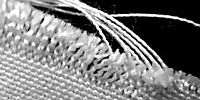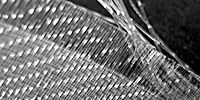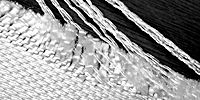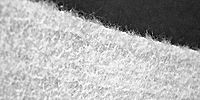
Products
A Sketch of Polypropylene Textile Cloths
by: Walter Senney, Met-Chem Group President
One of the most popular fibers used to manufacture fabric today is polypropylene. It can be woven into a variety of thread counts to allow from loose to tight filtration applications. Polypropylene is good for use in temperatures from 50°F to 180°F (Specification charts show use up to 250°F under limited applications is acceptable, (but I would not recommend it). The acceptable pH range for products filtered with polypropylene material is 2- 12. Polypropylene can be woven in the following ways:
 Multi-filament uses a number of fibers rolled together prior to weaving the cloth. This allows for a smooth finish and normally tight filtration. This cloth is normally used for filtration in pressure leaf filters for chemicals, liquid foods and some lower solids wastewater; as well as for anode bags in plating applications.
Multi-filament uses a number of fibers rolled together prior to weaving the cloth. This allows for a smooth finish and normally tight filtration. This cloth is normally used for filtration in pressure leaf filters for chemicals, liquid foods and some lower solids wastewater; as well as for anode bags in plating applications.
 Mono-filament uses a single fiber (like fishing line) to weave the cloth. This allows for a slick non-absorbing cloth that can be used in the same applications as multifilament, but is normally not as tight for filtration. This type of cloth works well for screening and more open filtration applications.
Mono-filament uses a single fiber (like fishing line) to weave the cloth. This allows for a slick non-absorbing cloth that can be used in the same applications as multifilament, but is normally not as tight for filtration. This type of cloth works well for screening and more open filtration applications.
 Mono/multi filament blend is a cloth woven out of both fibers, one is woven in one direction, while the other is woven in the other direction. This cloth can give us the best of both worlds in terms of tight filtration and a slick face for ease of cake removal. One of the major uses of this cloth is on filter presses for process filtration and heavy solid waste water applications.
Mono/multi filament blend is a cloth woven out of both fibers, one is woven in one direction, while the other is woven in the other direction. This cloth can give us the best of both worlds in terms of tight filtration and a slick face for ease of cake removal. One of the major uses of this cloth is on filter presses for process filtration and heavy solid waste water applications.
 Felt is the needle punching of these fibers into a thick material used regularly for filtration of paints, coolants and a variety of liquids. Micron ratings can go nominally from 1-100. These felts can be supported by an internal scrim or they can be non-supported. The supported felts can hang from a ring to filter, while the non-supported must be put in a pressure vessel supported by a basket to avoid blowout.
Felt is the needle punching of these fibers into a thick material used regularly for filtration of paints, coolants and a variety of liquids. Micron ratings can go nominally from 1-100. These felts can be supported by an internal scrim or they can be non-supported. The supported felts can hang from a ring to filter, while the non-supported must be put in a pressure vessel supported by a basket to avoid blowout.
This is just a thumbnail sketch of polypropylene textile cloths. These cloths can filter “the birds or the worms” depending on the type and tightness of the weave.